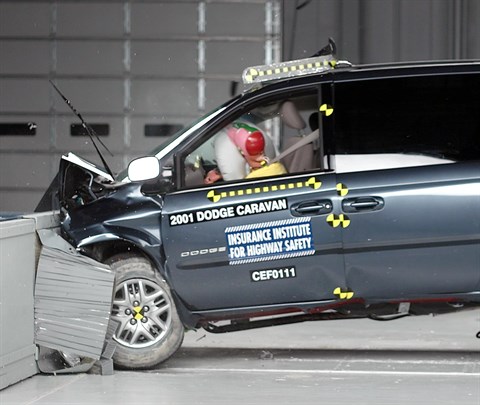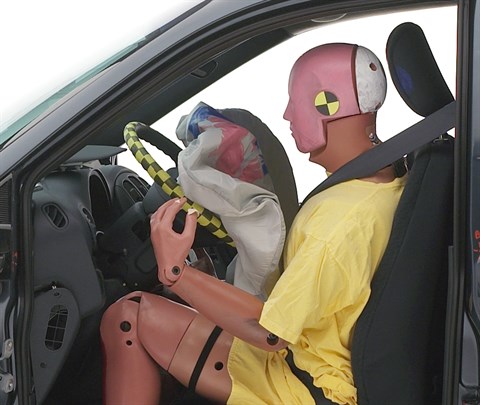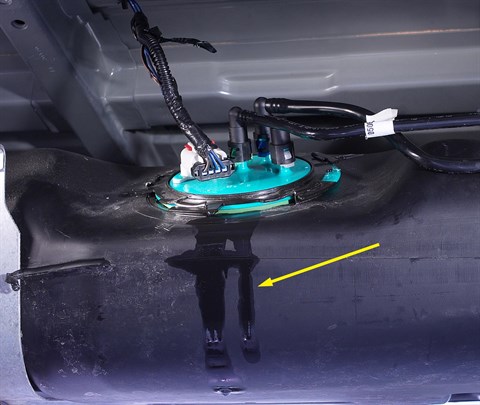Moderate overlap front: original test
Rating applies to 2002-07 models
Tested vehicle: 2001 Dodge Grand Caravan Sport
The Dodge Grand Caravan and Chrysler Town and Country were redesigned for the 2001 model year.
The Insurance Institute for Highway Safety has evaluated the crashworthiness of the Grand Caravan in three 40 mph moderate overlap frontal crash tests into deformable barriers. After the first test, Chrysler indicated the results were different from tests the company had conducted and requested a retest.
Results of the second test were more consistent with company test results for structural performance, but the amount and pattern of intrusion were similar. More significantly, a fuel leak occurred, revealing a weakness in the design of a circular fitting where the fuel lines exit the fuel tank. Further examination of the fitting in the van tested first showed stress fractures in the same area as the leak in the second van.
A third test was conducted after Chrysler made a design change to fix the fuel tank fitting and retrofitted a 2001 model with the redesign (all 2002 and later models include the modification). Examination of the redesigned fitting after the third test indicated no damage.
| Evaluation criteria | Rating |
|---|---|
| Overall evaluation | |
| Structure and safety cage | |
| Driver injury measures | |
| Head/neck | |
| Chest | |
| Leg/foot, left | |
| Leg/foot, right | |
| Driver restraints and dummy kinematics | |

Action shot taken during the last of three frontal offset crash tests.

The driver's survival space was maintained reasonably well, as indicated by the dummy's position in relation to the steering wheel and instrument panel after the third crash test.

The dummy's head bottomed out the airbag and hit the steering wheel in the first two tests. In the second test (pictured), there also was too much upward movement of the steering wheel.

In the second test, a large amount of the fluid in the fuel system leaked from a circular fitting (green plastic) on top of the fuel tank. Leaking fluid is visible (arrow) running down the side of the black plastic fuel tank.
Measures of occupant compartment intrusion on driver side
| Evaluation criteria | Measurement | ||
|---|---|---|---|
| Test ID | CEF0102 | CEF0111 | CF00028 |
| Footwell intrusion | |||
| Footrest (cm) | 7 | 9 | 10 |
| Left (cm) | 14 | 19 | 24 |
| Center (cm) | 21 | 24 | 26 |
| Right (cm) | 20 | 22 | 26 |
| Brake pedal (cm) | 14 | 17 | 23 |
| Instrument panel rearward movement | |||
| Left (cm) | 0 | 1 | 4 |
| Right (cm) | 1 | 2 | 4 |
| Steering column movement | |||
| Upward (cm) | 11 | 9 | 8 |
| Rearward (cm) | -5 | -2 | 0 |
| A-pillar rearward movement (cm) | 1 | 2 | 2 |
Driver injury measures
| Evaluation criteria | Measurement | ||
|---|---|---|---|
| Test ID | CEF0102 | CEF0111 | CF00028 |
| Head | |||
| HIC-15 | 602 | 456 | 587 |
| Peak gs at hard contact | 81 | no contact | 71 |
| Neck | |||
| Tension (kN) | 2.0 | 1.9 | 1.8 |
| Extension bending moment (Nm) | 30 | 19 | 18 |
| Maximum Nij | 0.43 | 0.41 | 0.38 |
| Chest maximum compression (mm) | 34 | 41 | 51 |
| Legs | |||
| Femur force - left (kN) | 5.2 | 7.7 | 7.2 |
| Femur force - right (kN) | 1.9 | 1.6 | 2.1 |
| Knee displacement - left (mm) | 1 | 0 | 0 |
| Knee displacement - right (mm) | 3 | 2 | 2 |
| Maximum tibia index - left | 0.60 | 0.48 | 0.68 |
| Maximum tibia index - right | 1.70 | 1.27 | 1.06 |
| Tibia axial force - left (kN) | 1.8 | 1.2 | 0.9 |
| Tibia axial force - right (kN) | 9.3 | 6.6 | 7.1 |
| Foot acceleration (g) | |||
| Left | 63 | 59 | 71 |
| Right | 142 | 134 | 273 |
Head restraints & seats
Seat type: Seats with adjustable lumbar
| Overall evaluation | |
|---|---|
| Dynamic rating | |
| Seat/head restraint geometry |
| Seat type | Seats with adjustable lumbar |
|---|---|
| Geometry | |
| Backset (mm) | 72 |
| Distance below top of head (mm) | 78 |
| Seat design parameters | |
| Pass/fail | Fail |
| Max T1 acceleration (g) | 9.6 |
| Head contact time (ms) | 117 |
| Force rating | 1 |
| Neck forces | |
| Max neck shear force (N) | 87 |
| Max neck tension (N) | 635 |
Seat type: Seats with fixed head restraints
| Overall evaluation | |
|---|---|
| Dynamic rating | |
| Seat/head restraint geometry |
| Seat type | Seats with fixed head restraints |
|---|---|
| Geometry | |
| Backset (mm) | 85 |
| Distance below top of head (mm) | 125 |
| Seat design parameters | |
| Pass/fail | Fail |
| Max T1 acceleration (g) | 0.0 |
| Head contact time (ms) | |
| Force rating | 0 |
| Neck forces | |
| Max neck shear force (N) | |
| Max neck tension (N) | |
Seat type: Seats without adjustable lumbar
| Overall evaluation | |
|---|---|
| Dynamic rating | |
| Seat/head restraint geometry |
| Seat type | Seats without adjustable lumbar |
|---|---|
| Geometry | |
| Backset (mm) | 82 |
| Distance below top of head (mm) | 75 |
| Seat design parameters | |
| Pass/fail | Fail |
| Max T1 acceleration (g) | 12.2 |
| Head contact time (ms) | 101 |
| Force rating | 3 |
| Neck forces | |
| Max neck shear force (N) | 231 |
| Max neck tension (N) | 900 |
About the head restraint & seat test
Currently, IIHS tests apply only to front seats.